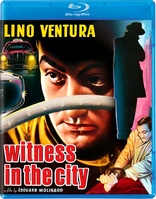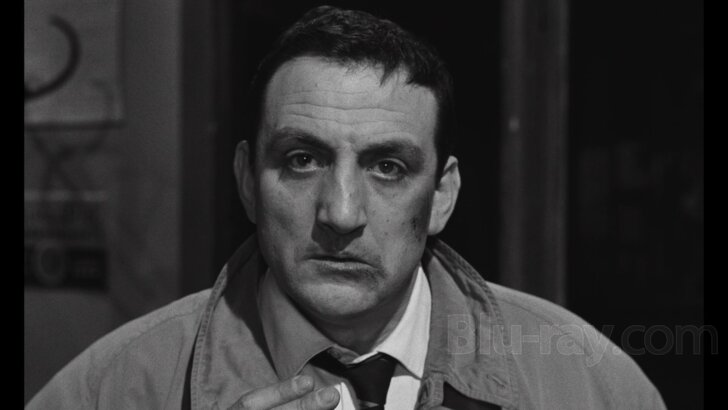Witness in the City Blu-ray Movie
HomeWitness in the City Blu-ray Movie 
Un Témoin Dans la VilleKino Lorber | 1959 | 89 min | Not rated | No Release Date

Price
Movie rating
7.2 | / 10 |
Blu-ray rating
| Users | 0.0 | |
| Reviewer | 2.0 | |
| Overall | 2.0 |
Overview
Witness in the City (1959)
Industrialist Pierre Verdier kills his mistress Jeanne Ancelin by throwing her off a train. Her husband, Ancelin, decides to take revenge on his wife's murderer...
Starring: Lino Ventura, Sandra Milo, Franco Fabrizi, Jacques Berthier, Daniel CeccaldiDirector: Édouard Molinaro
| Foreign | Uncertain |
| Drama | Uncertain |
| Film-Noir | Uncertain |
| Crime | Uncertain |
| Thriller | Uncertain |
Specifications
Video
Video codec: MPEG-4 AVC
Video resolution: 1080p
Aspect ratio: 1.66:1
Original aspect ratio: 1.66:1
Audio
French: DTS-HD Master Audio 2.0
Subtitles
English
Discs
Blu-ray Disc
Single disc (1 BD)
Playback
Region A (locked)
Review
Rating summary
| Movie | 4.0 | |
| Video | 2.0 | |
| Audio | 5.0 | |
| Extras | 0.5 | |
| Overall | 2.0 |
Witness in the City Blu-ray Movie Review
Reviewed by Dr. Svet Atanasov December 13, 2022Edouard Molinaro's "Witness in the City" a.k.a. "Un témoin dans la ville" (1959) arrives on Blu-ray courtesy of Kino Lorber. The only supplemental feature on the release is a vintage French trailer for the film. In French, with optional English subtitles for the main feature. Region-A "locked".

Who is the bad guy in Edouard Molinaro’s thriller Witness in the City (Un temoin dans la ville)? If you name the character played by the great Lino Ventura, Ancelin, you are effectively downgrading Witness in the City to just another conventional thriller, which it is not. But Molinaro’s camera captures the moment when Ancelin kills a man and then begins following a random taxi driver that has seen him leaving the crime scene. Ancelin wants to kill the taxi driver too, so how can he not be a bad guy?
Witness in the City has a short prologue that reveals the reason Ancelin becomes a killer. On a fast-moving train, a man (Jacques Berthier) fights a woman (Francoise Biron), easily overpowers her, and throws her off. Shortly after, a somber prosecutor announces that the man has been cleared of all murder charges because there is not enough evidence to convict him. The prosecutor knows that the man standing before him is a killer, the lawyer representing the man knows too, but the case is closed, and the man heads back to his lavish home with a grin on his face.
Moments before Ancelin kills the man from the train in his lavish home, we learn that he is a wealthy industrialist who was romantically involved with Ancelin’s wife. Ancelin knew about their affair and hoped to reclaim his wife, but was too late. So, it turns out that Ancelin is a heartbroken husband who was seeking old-fashioned justice after the killer of his wife was exonerated. While exiting the killer’s home, Ancelin is seen by an overworked taxi driver (Franco Fabrizi), and after impulsively telling him that he is not his customer and allowing him to disappear into the shadows of the night panics and begins tracking him down because he is the only witness in the city that can connect him to the soon-to-be-discovered crime scene.
How does any of the above information not make Ancelin a bad guy? I will give you a few clues.
You will not have to look long and hard to discover numerous similarities between Louis Malle’s stunning directorial debut Elevator to the Gallows and Molinaro’s Witness in the City. These films were released at approximately the same time, share an equal appreciation of jazz, and have identical noirish personalities. Also, both were lensed by Henri Decae, arguably the greatest post-WWII French cinematographer, which is why their visuals are similarly striking.
Elevator to the Gallows and Witness in the City have identical plot structures as well. I would not argue that the latter might have imitated the former because many earlier film noirs have similar plot structures, but this is an important detail. Indeed, in both films, the drama is a byproduct of a domino effect of errors. In Elevator to the Gallows, Malle frequently alters the audience’s viewing angle but only because there are more domino pieces falling simultaneously in different directions. In Witness in the City, a similar split occurs only toward the end, after Ancelin is identified.
The falling domino pieces are what makes Witness in the City an interesting film because they reveal how life can be rationalized as an ongoing cycle of consequential events, each with a crucial redirecting point. For example, if Ancelin reacts to his wife’s affair earlier, she lives, he does not kill her secret lover, and his life has a different trajectory. If Ancelin exits the murder scene unnoticed, he does not become a hunter, and his life has a different trajectory again. If Ancelin learns that the killer of his wife is convicted, he remains a grieving man, but his anger gradually subsides, and his life has a different trajectory again. So, identifying the crucial redirecting point transforms Witness in the City into a very interesting cinematic test. (In Elevator to the Gallows, there are numerous such consequential developments with identical crucial redirecting points as well).
Now, ponder this as you view Witness in the City: is there a moment, or moments, where Ancelin can interrupt the falling dominos? If yes, is he still a bad guy after that? Or is his profile as a bad guy completed at the police station once the wealthy industrialist is exonerated?
Witness in the City Blu-ray Movie, Video Quality 

Presented in its original aspect ratio of 1.66:1, encoded with MPEG-4 AVC and granted a 1080p transfer, Witness in the City arrives on Blu-ray courtesy of Kino Lorber.
Witness in the City was beautifully restored in 2K by Gaumont in France and a few years ago made its high-definition debut via this Blu-ray release. Unfortunately, the master that was prepared by Gaumont after the 2K makeover is very problematic. In case you are wondering, the same faulty master that was supplied to Kino Lorber for this release was also used to produce the earlier French release.
The entire master has been finalized with improper film-to-video levels that collapse the native dynamic range of the visuals. As a result, instead of producing proper blacks, the master produces odd grays that flatten the visuals and often make them appear as if they are heavily filtered. You can see examples of the effects of the improper conversion in screencaptures #16, 17, 18, 19, and 20. Depending on how the camera captures light and shadow(s), vast portions of the film can have a very digital appearance because of the gray blocks that flatten the visuals. Also, a lot of the flattening is accompanied by distracting chroma noise, which is introduced by the improper conversion as well. You should be able to see the chroma noise in screencapture #1. On top of all of the above, there is plenty of good old-fashioned macroblocking, which I believe is present on the faulty master as well. All of these anomalies are part of a well-known conversion practice that affected numerous early masters that were prepared at Gaumont. (Another high-profile title that was affected by it is A Man Escaped, but there are many others). So, the 2K makeover of Witness in the City is excellent, but a competent party will have to access the raw files again and prepare a brand new proper master so that when the film transitions to Blu-ray it looks as good as it should. (Note: This is a Region-A "locked" Blu-ray release. Therefore, you must have a native Region-A or Region-Free player in order to access its content).
Witness in the City Blu-ray Movie, Audio Quality 

There is only one standard audio track on this Blu-ray release: French DTS-HD Master Audio 2.0. Optional English subtitles are provided for the main feature.
It is immediately very obvious that the audio has been fully remastered. The dialog is very clear, sharp, and always easy to follow. There are no stability issues. I would describe dynamic intensity as excellent as well, but as always, you need to keep in mind that Witness in the City comes from the 1950s and has native limitations that make it impossible to produce striking dynamic contrasts. The English translation is very good.
Witness in the City Blu-ray Movie, Special Features and Extras 

- Trailer - presented here is a vintage French trailer for Witness in the City. (3 min).
Witness in the City Blu-ray Movie, Overall Score and Recommendation 

Is Ancelin's profile completed and fate predetermined as soon as the camera captures him killing the wealthy industrialist? If you said yes, you should pick another night to view Witness in the City again because it is not the simple thriller your answer suggests. There are a lot of interesting threads in it to identify and ponder, and if you do, you will discover a very different film. Witness in the City was completed just months after Louis Malle's terrific directorial debut, Elevator to the Gallows, and both films have almost identical stylistic personalities. I don't think this is surprising because they were lensed by the same man, Henri Decae, who is widely considered to be the greatest post-WWII French cinematographer. Unfortunately, this release offers a flawed technical presentation of Witness in the City. It is included in Kino Lorber's French Noir Collection, a two-disc set.
Similar titles
Similar titles you might also like
(Still not reliable for this title)

Elevator to the Gallows
Ascenseur pour l'échafaud
1958

Speaking of Murder
Le rouge est mis
1957

Rififi
Du rififi chez les hommes
1955

Le Samouraï 4K
1967

Bullhead
Rundskop
2011

Sympathy for Mr. Vengeance
Ultimate Revenge Edition
2002

The Facts of Murder
Un maledetto imbroglio | Limited Edition
1959

Back to the Wall
Le dos au mur
1958

The Bad Sleep Well
悪い奴ほどよく眠る / Warui yatsu hodo yoku nemuru
1960

Stray Dog
野良犬 / Nora inu
1949

Shoot the Piano Player 4K
Tirez sur le pianiste
1960

Pale Flower
乾いた花 / Kawaita hana
1964

A Touch of Sin
天注定 / Tian zhu ding
2013

Rififí in the City
Rififí en la ciudad
1963

Mauvais Sang
The Night is Young | Special Edition including Mr. X
1986

Lilya 4-ever
2002

Le jour se lève
Daybreak
1939

Pixote
Pixote: A Lei do Mais Fraco
1980

Touchez Pas au Grisbi
Don't Touch the Loot
1954

Pieta
피에타
2012